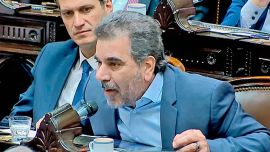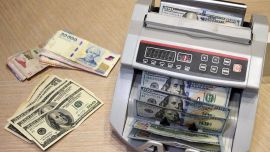Times change but the problems remain the same. The discussions about the exchange rate and the gap go back to way back when, with abundant experience from which to learn. In Argentina, we surely have more knowledge of these issues than any other country, although it would seem we haven’t learned much. Instead of seeking in-depth solutions using known strategies, we have generally gone for shortcuts to emerge from the quagmire of backwardness and the exchange rate gap, when the solution lies in an economic programme attacking the underlying problems.
The question in the air is whether or not the exchange rate lags behind. Probably not in traditional terms as in the last stages of the tablita fixed devaluation timetable of José Martínez de Hoz in 1980 or in the last period of convertibility or the close of the Cristina Fernández de Kirchner presidency. In those years there was no doubt that Argentina was an expensive country in dollar terms and in all those cases the ending was foreordained – a devaluation to restore a competitive exchange rate. Just as now, the ministers of those times said no way they were going to devalue but needs must and in the end they succumbed to market pressures.
The current situation is a bit different. When you analyse the real level of the exchange rate (i.e. adjusted for inflation), which is one form of measuring whether the country is expensive or cheap in dollars, an exchange rate lag is not obvious. The exchange rate in real terms is around the average of the last 30 years so that our official dollar is apparently neither cheap nor expensive. Furthermore, the economy is running a more than acceptable trade surplus of some US$14 billion, something which does not normally happen when the exchange rate lags behind competitive levels. So one possible reading is that the official exchange rate is balanced, which would make parallel exchange rates like the cable dollar (contado con liquidación, or CCL) super high.
Nevertheless, at first sight that does not necessarily seem so. Exchange rate balance is a theoretical concept which only makes sense in a long-term analysis. In the short term if the cycle is complex, a country might need a higher exchange rate than the balanced and lower if the cycle is more benign. The problem is that the exchange rate does not only balance the trade figures (something which does depend on whether a country is expensive or cheap in dollars) but mainly serves to even out the balance of payments, including capital inflow and outflow.
The current real exchange rate would be reasonable if the economic conditions were reasonable, but they are not in today’s Argentina. Net reserves of some US$6 billion are not reasonable when at least US$35-40 billion are needed. A country risk of 1,600 points implying that the government has no access to external financing nor the private sector credit for investments is not reasonable. It is not reasonable that the MSCI (Morgan Stanley) has rated us as “Stand Alone,” a category similar to Lebanon, a country which is imploding. Nor is it reasonable that an economy needs to impose extreme supercepo capital controls and tolerate an exchange rate gap of 80 percent to avoid losing its few remaining reserves.
Given that the conditions are not reasonable and that there are moments of financial turbulence, in which the country suffers a severe capital exodus, the official exchange rate does not suffice to balance money markets as a whole. In other words, you might say that the exchange rate is OK for commercial operations but low for financial operations. The problem is that in general there is only a single exchange rate for both types of transaction and that in practice and that in the short term a unified exchange rate tends to be determined mainly by financial flows and by trade to a lesser degree. That does not just happen in Argentina – it’s a universal phenomenon.
In Argentina the solution found to deal with this dichotomy was to adopt two exchange rates. On the one hand, we have the official dollar, which is mainly for exports and imports and very few capital transactions (a commercial dollar) and on the other hand, the CCL, used for savings and capital movements (a financial dollar). This reality cannot be maintained for long, especially with a gap of 80 percent in which there are enormous incentives to seek mechanisms permitting the purchase of dollars at the official rate and sale at the parallel rate. That is the reason why these schemes do not last and after a while a unification of exchange markets is sought or at least a significant reduction of the gap.
The big question is how, when and with what exchange rate the market can be unified (or at least the gap significantly narrowed). In Argentina the exercise is much more complicated because inflation is around 50 percent annually and a false step in reducing the gap could lead to a fresh surge in inflation, as has so often happened.
The ideal would be to lower the parallel dollar but unless there is a significant change in country risk, international reserves, interest rates and confidence levels, this will be difficult to achieve – this sounds like a mission impossible. Experience indicates that in most cases unification is closer to the financial rate than to the official.
The remaining options would be an exit in the style of then-Central Bank governor Juan Carlos Fábrega in 2014 – i.e. a 15-20 percent devaluation to narrow the gap – or alternatively to accelerate daily depreciation rates ahead of inflation for several months until a significant decline in the exchange rate lag can be observed. Both options are risky because they could increase inflation without lowering the gap.
There are no simple alternatives. Continuing the current chasm is a recipe for continuing to lose reserves and stiffening the cepo currency controls, thus threatening economic revival and halting investments. Devaluation or accelerating currency depreciation without an economic programme could end in price increases neutralising the effects of the improved exchange rate instead of helping to narrow the gap. Generating a change of expectations to lower the CCL does not seem viable for now.
Unfortunately, I have no recipe for resolving this issue and I don’t believe that there is anybody who does. What is for sure is that without an integral programme to improve confidence, reduce the fiscal deficit, improve the reserves and be implemented within the framework of an agreement with the International Monetary Fund, the exchange rate problem will grow more acute instead of being resolved.




















Comments